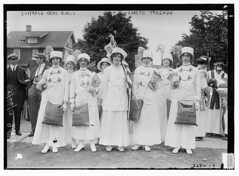
Suffrage news girls - Liz Freeman (LOC); Image courtesy of Library of Congress, Prints and Photographs Division, Washington, D.C. 20540 USA, hdl.loc.gov/loc.pnp/pp.print
We are in the final weeks leading up to a presidential election. One of Illinois State’s core values is civic engagement. It would seem, on the surface, at least, a no brainer to find ways to discuss and critically evaluate the issues and the candidates in our courses in an effort to encourage our students to engage in the democratic process.
But it isn’t really quite a no brainer. We have to remember that politics can be highly controversial and requires a great deal of planning on our part to make sure it remains a learning experience for our students. If not done carefully, it can quickly devolve into the type of mudslinging often found in the comments section of online news outlets and blogs.
According to Diana Hess, author of Controversy in the classroom: The democratic power of discussion (2009, New York: Routledge), we need to determine if a controversial issue is closed, open or tipping.
- Closed questions are those that are no longer considered controversial, such as women’s suffrage.
- Open questions are those that are still considered controversial, such as gun control.
- Tipping questions are those moving from open to closed.
I think it is actually the tipping questions that we need to watch out for because we and many students may view the question as closed while some students may view it as still open or vice versa.
We also need to keep in mind (and help our students understand) that there are differences between
- Topics, problems, and issue
- Current events and issues
- Specific case issues and larger perennial issues
- Public and private issues
- Political issues and Constitutional issues
One idea that I really like is the 3Ds: Debate, Discussion, and Deliberation exercise. While it is geared for high school, I think it can be adapted for use in the college classroom. Essentially, we discuss what a debate is and then tell our students we won’t be doing it in the classroom. We then talk about what a discussion is and then tell our students that we won’t be engaging in discussion, either. Finally, we explain what deliberation is and tell them that they will be engaging in the democratic process of deliberation.
We don’t have to shy away from discussing politics in the classroom if it will help your students reach your learning goals for them. However, we need to teach them how to engage in a meaningful dialogue before we even begin to ask provocative questions.
What is your experience with discussing politics in the classroom?
Resources for Further Exploration
- CTLT’s “Little Idea for Teaching” Strategy: Discussion of Controversial Issues
- Teaching Controversial Issues
- American Democracy Project at ISU website
- Deliberating in a Democracy website
